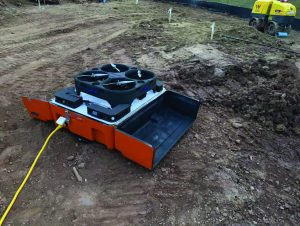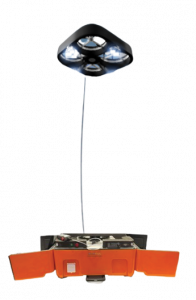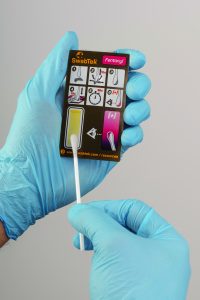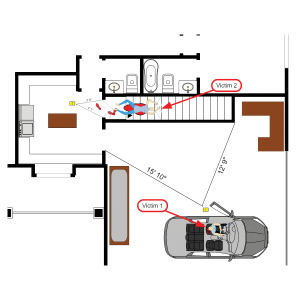It takes several types of tools to process a crime scene. Barrier tape, evidence bags, measuring devices, and first aid kits may all be traditional, albeit necessary, items to have readily available.
However, there may be more unique tools available to law enforcement professionals that could be useful in obtaining as much evidence as possible. “It is important that officers are equipped with as many tools and resources as possible to allow them to make effective and informed decisions,” said Mitchell Ballachay, Strategic Projects at SwabTek.1
Processing a Scene
Crime scene examination is complex and has several moving parts. Preserving a crime scene is one of the most important responsibilities of a first responder to maintain order and safety in their community. It is critical that evidence is not destroyed or contaminated, as it would lose its value in the investigation. Therefore, one of the first steps is to identify the scene dimensions and establish a perimeter to contain relevant evidence.2

To properly do so in limited light conditions, the use of Blue Vigil’s ALED could be an effective option. The idea for the portable light initially came out of the construction world. Construction sites typically have large pole lights that shine across the area being lit. This results in a large amount of glare and shadow, often blinding drivers. “The same problems that caused them to be far from ideal on construction zones, turns out are almost identical problems when you get into public safety areas,” said Blue Vigil’s Chief Executive Officer Rob Schumann.3
With Blue Vigil’s previous knowledge of drones and existing power tether technology, developers set out to create a more effective lighting solution. After about a year and a half, the ALED portable light came to fruition. Rather than shining across an area, the ALED light shines straight down, eliminating glare and shadows.

Packed into a 31″ wide by 41″ long suitcase, the electronics altogether weigh around 90 pounds. Its size makes it unique as most officers must wait several minutes—if not hours—for a lighting system to arrive on scene. The case can be easily stored in a command vehicle and can be carried or rolled to exactly where it is needed. All that an officer needs is an inverter from a command vehicle or small generator. The suitcase opens like a clamshell to reveal the drone, remote controller, and power tether.
Once plugged into a power source, the drone rises and stays directly above the case on the ground. The tether provides constant energy to the drone, which could virtually keep it in the air indefinitely. The drone flies up to 100 feet into the air; however, when the light is brought down slightly, the focus area contracts and more intense and brighter light shines onto the ground. Designed to be a robust system, ALED is not just a “fair weather tool.” It is designed to operate in rainy and windy conditions. In up to 25 mph winds, the drone will remain in the air with some sway, but the lights will not move. This is because the lights are on gimbals.
The betas for ALED will be arriving Winter 2023, and the lighting system will be available to the public by Summer 2024.

Once a perimeter has been established and the area is properly lit, crime scene investigators can begin processing the visible evidence. “When in the field, every datapoint could be essential in safely and thoroughly processing crime scenes,” said Ballachay.4 Unfortunately, when forensics tools cannot be relied on due to safety concerns, the amount of information available at a scene reduces. Many agencies have reduced the role of—or eliminated altogether—presumptive field tests because of their inherent risk. Traditionally, presumptive field tests rely on hazardous chemical components, such as formaldehyde or chloroform. To use these tests, officers would have to break glass vials or ampoules containing the dangerous chemicals with their hands. This would often result in injuries from broken glass and exposure to the chemical components of the test.
SwabTek set out to prioritize officer safety in making presumptive field tests for the detection of narcotics, explosives, and gunshot residue useful in the policing profession. The test kits rely on color chemistry like other tests, but SwabTek has replaced the hazardous and carcinogenic liquid reagents with safe and non-toxic dry reagents. The glass vial delivery of the test has also been replaced with a swab and paper test cards. Officers can gently swab a suspected material and transfer it to a test card. When a sample is combined with the reagent printed on the test card, a result is indicated by an immediate color change. SwabTek’s tests are safe to dispose of with normal trash once results have been captured.
With the help of SwabTek’s presumptive field tests, evidence can remain undisturbed and officers can prioritize their safety during sample collection.
A diagramming tool becomes useful once the scene is cleared. Investigators no longer have to recall the scene through photographs or reports; Trancite’s Scene PD allows officers to revisit a crime scene through a user-friendly diagramming software. “This professional depiction of the scene augments law enforcement reports to give a complete picture of the scene,” said Aaron Baumert, global director of sales at Trancite.5

ScenePD features over 1,300 intelligent symbols that an officer can drag and drop accordingly. The software also includes structures, streets, and symbols that know how to interact with each other. With these features, drawing streets, sidewalks, parking structures, and residential homes takes only a few mouse clicks. A user can then add details like body position, weapons, and other evidentiary items. Once drawn, the crime scene can be annotated to include photographs, audio, and video.
Used with Trancite’s full-service evidence collection software, AccuraCSI, ScenePD allows investigators to gather all relevant information from one place, including evidence, photo logs, event logs, narratives, teams, and much more. “Tools like ScenePD and AccuraCSI save law enforcement officers time,” said Trancite’s director of sales, federal accounts, Richard Harris. “In fact, federal law enforcement agencies save 85 percent of their time by using AccuraCSI.”6 The output that the two tools deliver allows for a better understanding of what was found and where it was found in a crime scene.
Conclusion
From location to evidence, every crime scene is unique, which determines how investigators would approach it; therefore, officers must have unique crime scene tools that help preserve the evidence while keeping everyone safe.d
|
SOURCE LIST |
|
Notes:
1Mitchell Ballachay (strategic projects, SwabTek), email interview, September 27, 2023.
2https://online.campbellsville.edu/infographics/7-steps-of-a-crime-scene-investigation/
3Rob Schumann (chief executive officer, Blue Vigil), phone interview, September 7, 2023.
4Ballachay, email interview.
5Aaron Baumert (global director of sales, Trancite), email interview, September 19, 2023.
6Richard Harris (director of sales, federal accounts, Trancite), email interview, September 19, 2023.


